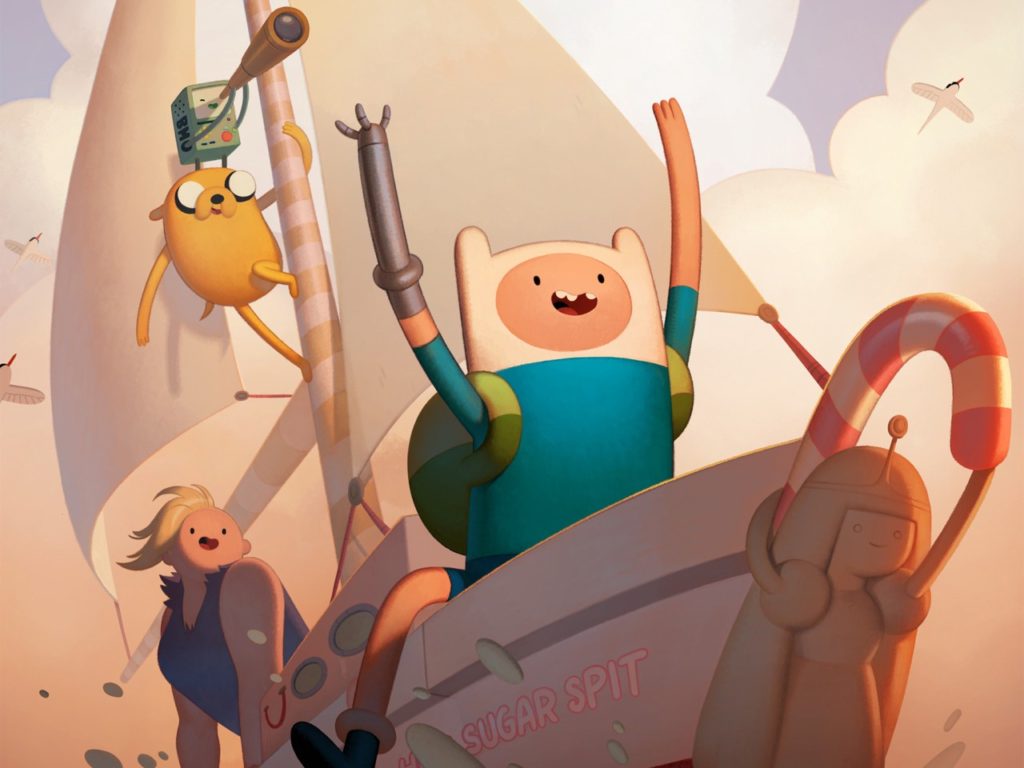Cast your minds, O Children, like a rapidly anthropomorphizing fishing rod and reel leaping its way out of the transmogrifying powers of Fantasia back to 2001 with John Berger taking the time to write about both Francis Bacon and Walt Disney: per Berger, one did for human portraiture something akin to what Mark Rothko did for abstraction. The other was a cartoonist.
And what happens if you combine a painter who crafted images where “the worst has already happened” with a cartoon? What do you do when you bring a cartoonist into a room after the artist has just admitted his desire to “paint the scream more than the horror?” You get and receive Adventure Time.
Adventure Time: Islands — a miniseries that featured Finn meeting humans and his mother that closed out the latter half of season 8, the penultimate season of the show — begins with a joke about a funeral and ends with a goodbye. Now that the show’s final season has been put to rest, it’s time we returned to Islands, and its gorgeous imagery.
Let’s start with the treehouse: it sits at the center of this frame all but soaked in warm colors. The clouds blow across the frame and up out of it in a rightward streak. It is a centering image. That is an initial step in the footwork of our vocabulary here.
This particular vocabulary stands in stark contrast to another strand of animation. “Disney’s world is … charged with vain violence,” Berger continues in the essay. “The ultimate catastrophe is always in the offing. His creatures have both personality and nervous reactions: what they lack (almost) is mind.”
In Islands, there’s one scene where Finn’s mother looks out at the ocean, and the clouds arc like papers blowing away again. The sun sets again. The shot echoes Jeff Wall’s “A Sudden Gust of Wind (After Hokusai).” The images feel complementary, like they could be cut together in a trick of editing and subsequently render a story.
Berger comes to the conclusion of Bacon’s work that “We see character as the empty cast of a consciousness that is absent … Living man has become his own mindless spectre.”
And there is certainly a whole island devoted to those who pursue a life where “character [is] the empty cast of a consciousness that is absent.” Whole hordes of humans pursue life in virtual reality, one which — once it’s revoked — seems soaked in defeat: an old man tries to summon a sword to take a swing at Jake for daring to “rescue” him, but the sword never comes. The running strand of critique in Amusing Ourselves to Death (both Neil Postman’s book and the Roger Waters album of the same name) has continued, expanded, and claimed an island of its own. It hangs around our culture like the kid who never left home, still telling the same story at the same bar night after night while beekeepers stare at the glowing insects of politics that buzz about the field.
So why can we subsequently turn around and say that the art here — that is, the art of Adventure Time — has “soul?” Why do those particular moments come to us? Does this happen to you when you read comics? Does it happen to you with Far Side? What about Calvin and Hobbes?
And what do we make of the sprinkling of lights across Martin and Minerva? Why is the window slanted in the way that it is? Can we really take the overabundance of flowers to be anything other that what it’s intending to be?
“What is the name of this wind that blows?” Finn seems to ask as he looks out from the top of his tree house — as his mother looks out from the edge of the shore; as Wall asks; and as Bacon and Disney do not ask (one to make a point; the other because he does not know.)
But one more person does ask that question, someone worth mentioning here, and it creates a strange feeling when you think about this when watching Islands. The English philosopher John Locke once argued that it wasn’t “a mighty necessity to determine one way or t’other, as some overzealous for or against the Immateriality of the Soul, have been foreward to make the World believe,” because consciousness — in his view — was continuous, a river, a wind, and an adventure worthy of exploration.
Thanks for reading The Dot and Line, where we talk about animation of all kinds. Don’t forget to👏 for this article and follow us on Twitter and Facebook.
